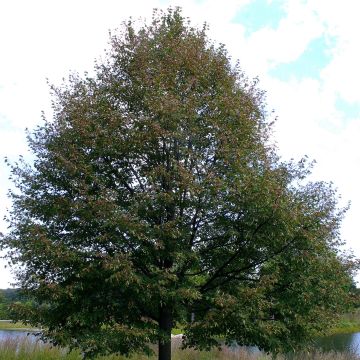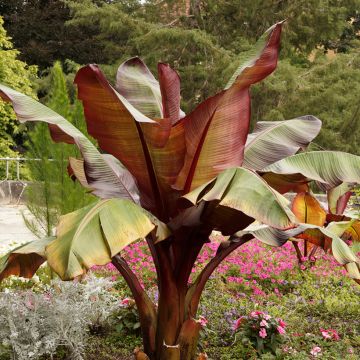

Tilia x europaea Wratislaviensis - Common Lime


Tilia x europaea Wratislaviensis - Common Lime
Tilia x europaea Wratislaviensis - Common Lime
Tilia x europaea Wratislaviensis
Common Lime, European Lime
Special offer!
Receive a €20 voucher for any order over €90 (excluding delivery costs, credit notes, and plastic-free options)!
1- Add your favorite plants to your cart.
2- Once you have reached €90, confirm your order (you can even choose the delivery date!).
3- As soon as your order is shipped, you will receive an email containing your voucher code, valid for 3 months (90 days).
Your voucher is unique and can only be used once, for any order with a minimum value of €20, excluding delivery costs.
Can be combined with other current offers, non-divisible and non-refundable.
Home or relay delivery (depending on size and destination)
Schedule delivery date,
and select date in basket
This plant carries a 24 months recovery warranty
More information
We guarantee the quality of our plants for a full growing cycle, and will replace at our expense any plant that fails to recover under normal climatic and planting conditions.
Would this plant suit my garden?
Set up your Plantfit profile →
Description
Tilia x europaea 'Wratislaviensis' is a more than a century-old variety of Common Lime tree native to Poland. This beautiful tree is of medium to large size, but it is more compact and better suited to today's gardens than the larger parent species. Its foliage is particularly decorative with its changing colours throughout the season. The young leaves emerge yellow in spring and gradually turn green. Young shoots continue to form in summer, starting off butter yellow and contrasting nicely with the now green foliage. In autumn, the tree turns yellow with hints of orange before the leaves fall to the ground. In June, this Lime tree produces the same fragrant white flowers as the botanical species, delighting bees.
The Lime tree is a representative member of the Tiliaceae family, and by far the most well-known, although this botanical family comprises around fifty genera and approximately 450 species! Tilia x europaea, European Lime or Common Lime, is a hybrid between T. cordata, a species with small leaves and T. platyphyllos, or Big-leafed Lime. The European Lime, a hybrid created hundreds of years ago and named by the famous botanist Linnaeus in 1751, is, like its parents, a tall tree capable of reaching heights of 30m or more.
Wratislaviensis is probably a mutation of the 'Pallida' variety and was discovered in 1898 in Wroclaw, the third-largest city in the country, located in western Poland. Its growth is smaller than that of the botanical species, as 10 years after planting, it will reach approximately 6m in height and 4m in width, while its mature size will peak at 15m in height and 10m in width. It naturally takes on a pyramidal to conical shape, very regular and balanced, which closely resembles the shape of its leaves. These leaves are heart-shaped, with an acuminate (pointed) tip and a slightly asymmetrical cordate (heart-shaped) base (the lower part of the leaf forms two rounded lobes on either side of the petiole). The fairly large leaves measure from 7 to 10cm in length and 6 to 9cm in width, and their edges are finely toothed. They are especially remarkable for their colour, which changes throughout the season. In spring, yellow leaves emerge, giving the tree a very bright appearance, before turning green in summer. On this green foliage, new shoots appear in a butter-yellow colour, forming a halo around the Lime tree's crown. This visual effect is more pronounced in young, rapidly growing specimens, as mature trees produce fewer summer shoots. Finally, in autumn, the foliage turns yellow with hints of orange to end the season on a beautiful note before the leaves fall.
Like its counterparts, this Lime tree is also appreciated for its flowering. In June, it produces pendulous corymbs composed of 3 to 11 cream-white, fragrant flowers, which attract bees.
This beautiful tree, with its regular and attractive architecture, is appealing due to the brightness of its foliage, which can tolerate full sun. It is well-suited to medium to large gardens, being ornamental enough to justify being planted as a specimen tree on a lawn, and can also be the centrepiece of a mixed bed. Play with colour and form contrasts by planting Sambucus nigra Black Lace Eva at its base, an Elderberry with finely cut, almost black foliage that contrasts nicely with the Lime tree's yellow and produces beautiful pink flowers in May-June, which stand out against the dark foliage. A Cercis canadensis Eternal Flame will also create a surprise with its changing foliage, dark red in spring when the Lime tree is yellow, then turning orange and yellow to blend in with the Lime tree, before greening like it in summer and colouring again in autumn. Its pinkish-purple flowers, appearing directly on the wood before the leaves, are also a spectacle on their own, at the beginning of each season. And in the foreground, plant a Winged Spindle (Euonymus alatus) whose foliage will turn bright red in autumn, completing your colourful scene.
Report an error about the product description
Plant habit
Flowering
Foliage
Botanical data
Tilia
x europaea
Wratislaviensis
Tiliaceae
Common Lime, European Lime
Tilia x Wratislaviensis
Cultivar or hybrid
Other Tilia - Linden
View all →Planting and care
The Wratislaviensis Lime tree is best planted in autumn or spring. It is extremely cold-resistant, but it is best not to expose it to strong winds. A sunny exposure will suit it well or at most partially shaded. It adapts to most soils, except for really dry ones, with the ideal being a fertile, moist, well-drained soil, although it is capable of withstanding temporary water excesses. Soak the root ball in a bucket of water for fifteen minutes before planting and dig a hole 60 cm in width and depth. Mix planting compost with the existing soil, position the root ball, fill in around it, and water abundantly. Water regularly for the first two years to promote its establishment, and then only in hot and dry periods.
This tree requires little maintenance, but it can be attacked by aphids, which, by emitting honeydew, a sweet substance, create conditions for the development of sooty mould. This fungus darkens the leaves, which affects the aesthetics but is not harmful to the plant. Spray with black soap to get rid of it as long as the plant is not too tall to be treated.
Planting period
Intended location
Care
This item has not been reviewed yet - be the first to leave a review about it.
Similar products
Haven't found what you were looking for?
Hardiness is the lowest winter temperature a plant can endure without suffering serious damage or even dying. However, hardiness is affected by location (a sheltered area, such as a patio), protection (winter cover) and soil type (hardiness is improved by well-drained soil).

Photo Sharing Terms & Conditions
In order to encourage gardeners to interact and share their experiences, Promesse de fleurs offers various media enabling content to be uploaded onto its Site - in particular via the ‘Photo sharing’ module.
The User agrees to refrain from:
- Posting any content that is illegal, prejudicial, insulting, racist, inciteful to hatred, revisionist, contrary to public decency, that infringes on privacy or on the privacy rights of third parties, in particular the publicity rights of persons and goods, intellectual property rights, or the right to privacy.
- Submitting content on behalf of a third party;
- Impersonate the identity of a third party and/or publish any personal information about a third party;
In general, the User undertakes to refrain from any unethical behaviour.
All Content (in particular text, comments, files, images, photos, videos, creative works, etc.), which may be subject to property or intellectual property rights, image or other private rights, shall remain the property of the User, subject to the limited rights granted by the terms of the licence granted by Promesse de fleurs as stated below. Users are at liberty to publish or not to publish such Content on the Site, notably via the ‘Photo Sharing’ facility, and accept that this Content shall be made public and freely accessible, notably on the Internet.
Users further acknowledge, undertake to have ,and guarantee that they hold all necessary rights and permissions to publish such material on the Site, in particular with regard to the legislation in force pertaining to any privacy, property, intellectual property, image, or contractual rights, or rights of any other nature. By publishing such Content on the Site, Users acknowledge accepting full liability as publishers of the Content within the meaning of the law, and grant Promesse de fleurs, free of charge, an inclusive, worldwide licence for the said Content for the entire duration of its publication, including all reproduction, representation, up/downloading, displaying, performing, transmission, and storage rights.
Users also grant permission for their name to be linked to the Content and accept that this link may not always be made available.
By engaging in posting material, Users consent to their Content becoming automatically accessible on the Internet, in particular on other sites and/or blogs and/or web pages of the Promesse de fleurs site, including in particular social pages and the Promesse de fleurs catalogue.
Users may secure the removal of entrusted content free of charge by issuing a simple request via our contact form.
The flowering period indicated on our website applies to countries and regions located in USDA zone 8 (France, the United Kingdom, Ireland, the Netherlands, etc.)
It will vary according to where you live:
- In zones 9 to 10 (Italy, Spain, Greece, etc.), flowering will occur about 2 to 4 weeks earlier.
- In zones 6 to 7 (Germany, Poland, Slovenia, and lower mountainous regions), flowering will be delayed by 2 to 3 weeks.
- In zone 5 (Central Europe, Scandinavia), blooming will be delayed by 3 to 5 weeks.
In temperate climates, pruning of spring-flowering shrubs (forsythia, spireas, etc.) should be done just after flowering.
Pruning of summer-flowering shrubs (Indian Lilac, Perovskia, etc.) can be done in winter or spring.
In cold regions as well as with frost-sensitive plants, avoid pruning too early when severe frosts may still occur.
The planting period indicated on our website applies to countries and regions located in USDA zone 8 (France, United Kingdom, Ireland, Netherlands).
It will vary according to where you live:
- In Mediterranean zones (Marseille, Madrid, Milan, etc.), autumn and winter are the best planting periods.
- In continental zones (Strasbourg, Munich, Vienna, etc.), delay planting by 2 to 3 weeks in spring and bring it forward by 2 to 4 weeks in autumn.
- In mountainous regions (the Alps, Pyrenees, Carpathians, etc.), it is best to plant in late spring (May-June) or late summer (August-September).
The harvesting period indicated on our website applies to countries and regions in USDA zone 8 (France, England, Ireland, the Netherlands).
In colder areas (Scandinavia, Poland, Austria...) fruit and vegetable harvests are likely to be delayed by 3-4 weeks.
In warmer areas (Italy, Spain, Greece, etc.), harvesting will probably take place earlier, depending on weather conditions.
The sowing periods indicated on our website apply to countries and regions within USDA Zone 8 (France, UK, Ireland, Netherlands).
In colder areas (Scandinavia, Poland, Austria...), delay any outdoor sowing by 3-4 weeks, or sow under glass.
In warmer climes (Italy, Spain, Greece, etc.), bring outdoor sowing forward by a few weeks.














































